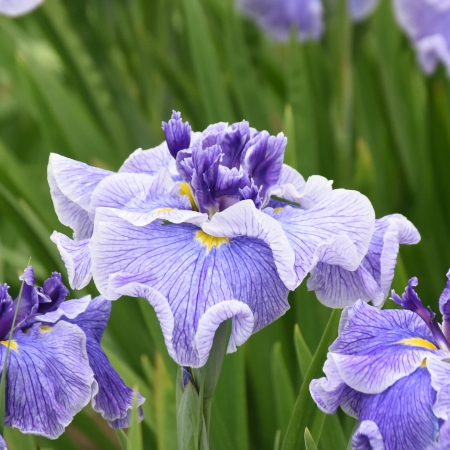Iris ensata (Japanese Iris)
×
Color Name: Center of Attention
Transform your garden with the striking beauty of Iris ensata Center of Attention. This Japanese Iris features large, violet-blue flowers with ruffled edges and dark purple signals, creating a mesmerizing focal point. Blooming later than Siberian Iris, Center of Attention graces your garden with its presence, extending the iris season.
Unlike the Tall Bearded Iris, the beardless Japanese Iris has a flat bloom, narrower leaves, and smaller, more compact rhizomes. They have the largest flowers of all irises, and make wonderful spring accents for the edge of water gardens. Japanese irises are the latest to bloom, about a month after the Siberian irises.
Growing Tips: Location: Choose a spot with full sun (at least six hours per day) for the best blooms. Afternoon shade is beneficial in very hot climates.
Soil: These plants prefer rich, acidic soil with a pH of 5.0-6.5.
Mix in plenty of organic matter, such as compost or well-aged manure, to improve fertility and moisture retention. Do not add lime or wood ash, as this is harmful to Japanese irises.
Depth: Plant the rhizomes deeper than other iris varieties, about 2 to 3 inches deep, to account for their upward growth habit.
Spacing: Space individual rhizomes 18 to 24 inches apart to give them room to grow.
Initial care: After planting, soak the roots overnight before planting, and water thoroughly to settle the soil.
Transform your garden with the striking beauty of Iris ensata Center of Attention. This Japanese Iris features large, violet-blue flowers with ruffled edges and dark purple signals, creating a mesmerizing focal point. Blooming later than Siberian Iris, Center of Attention graces your garden with its presence, extending the iris season.
Unlike the Tall Bearded Iris, the beardless Japanese Iris has a flat bloom, narrower leaves, and smaller, more compact rhizomes. They have the largest flowers of all irises, and make wonderful spring accents for the edge of water gardens. Japanese irises are the latest to bloom, about a month after the Siberian irises.
Growing Tips: Location: Choose a spot with full sun (at least six hours per day) for the best blooms. Afternoon shade is beneficial in very hot climates.
Soil: These plants prefer rich, acidic soil with a pH of 5.0-6.5.
Mix in plenty of organic matter, such as compost or well-aged manure, to improve fertility and moisture retention. Do not add lime or wood ash, as this is harmful to Japanese irises.
Depth: Plant the rhizomes deeper than other iris varieties, about 2 to 3 inches deep, to account for their upward growth habit.
Spacing: Space individual rhizomes 18 to 24 inches apart to give them room to grow.
Initial care: After planting, soak the roots overnight before planting, and water thoroughly to settle the soil.
|
Flower Color: Blue Shades Foliage Color: Green Shades
Height: 36 to 38 Inches Spread: 24 to 28 Inches Hardy in Zone: 4, 5, 6 |
Blooms: Late Spring / Early Summer
Foliage Season: All Season |
Growth Rate |
Medium
|
Attributes |
Border Cut Flower or Foilage Easy to Grow Landscapes Mass Planting Specimen Plant
|









